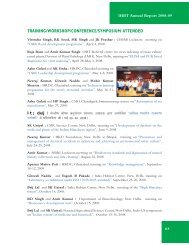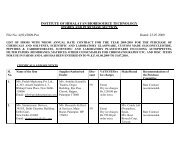Create successful ePaper yourself
Turn your PDF publications into a flip-book with our unique Google optimized e-Paper software.
CSIR-<strong>IHBT</strong> <strong>Annual</strong> <strong>Report</strong> 2010-11lycopersici (FOL) and Alternaria solani (AS) recorded low percent disease index of 25.3 and 28.7respectively, over non-bacterised pathogen control (44.3 and 56.4). The low disease incidencepromoted tomato growth with high vigour index (8041.2) and fresh plant weight (82.5 g).Analysis of root and leaf samples in rhizobacterial treatment challenged with FOL and ASrevealed maximum induction of chitinase (1.9 and 1.7 U/mg of protein, respectively) andβ-1,3-glucanase (23.5 and 19.2 U/mg of protein, respectively). In native gel activity assays,the rhizobacterial treatment on challenge inoculation revealed strong expression of three highintensity PO isoforms along with one low intensity isoform. PPO induction was noticed onlyin presence of pathogen in the root and leaf samples (Fig. 61). In studies on genetic diversityof the Bacillus strains, amplified rDNA restriction analysis (ARDRA) was highly discriminantthan repetitive extragenomic palindromic (REP)-PCR and allowed grouping of the strains anddifferentiation of the antagonistic strains from other isolates.Fig. 61 Native-PAGE analyses of induced a) PO and b) PPO in tomato roots and leaves by S2BC-2. Lanes 1 & 5: plantstreated with S2BC-2 challenged with FOL and AS, respectively, Lanes 2 & 6: plants treated with S2BC-2, Lanes 3 & 7:pathogenic control 4 & 8: untreated control; arrows indicate the isoforms67




